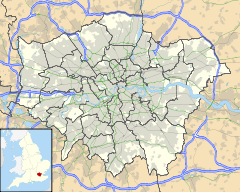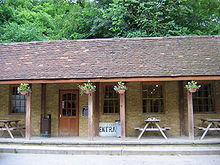- Chislehurst
-
Coordinates: 51°24′54″N 0°04′44″E / 51.4150°N 0.0789°E
Chislehurst
 Chislehurst shown within Greater London
Chislehurst shown within Greater LondonOS grid reference TQ445705 London borough Bromley Ceremonial county Greater London Region London Country England Sovereign state United Kingdom Post town CHISLEHURST Postcode district BR7 Dialling code 020 Police Metropolitan Fire London Ambulance London EU Parliament London UK Parliament Bromley & Chislehurst London Assembly Bexley and Bromley List of places: UK • England • London Chislehurst (
 /ˈtʃɪzəlˈhɜrst/) is a suburban settlement in south east London, England and an electoral ward of the London Borough of Bromley. It is 10.5 miles (16.9 km) south-east of Charing Cross.
/ˈtʃɪzəlˈhɜrst/) is a suburban settlement in south east London, England and an electoral ward of the London Borough of Bromley. It is 10.5 miles (16.9 km) south-east of Charing Cross.Contents
Toponymy
The name "Chislehurst" is derived from the Saxon words cisel 'gravel', and hyrst 'wooded hill'.
History
Camden Place (now Chislehurst Golf Club) takes its name from the antiquary William Camden, who lived in the former house on the site from c.1609 until his death in 1623. The present house was built shortly before 1717, and was given a number of additions in the late 18th and very early 19th centuries by the architect George Dance the younger.[1] In about 1760, the house and estate were bought by Charles Pratt, the Attorney General, and later Lord Chancellor. Pratt was ennobled in 1765, taking the title Baron Camden, of Camden Place: in 1786 he was created Earl Camden. A later occupant of the house, from 1871 until his death there in 1873, was the exiled French Emperor, Napoleon III. His body and that of the Prince Imperial were originally buried in St Mary's Church, before being removed to St Michael's Abbey, Farnborough. The Emperor's widow, the Empress Eugénie, remained at Camden Place until 1885. There is a memorial to Napoléon Eugène on Chislehurst Common, and the area's connections with the imperial family are found in many road names and in the local telephone code, 467, which in its earlier format corresponded to the letters IMP (for imperial).
Chislehurst Common (and nearby St Paul's Cray Common) were saved from development in 1888 following campaigns by local residents. They were a popular destination for bank holiday trips in the early 20th century, and now provide a valuable green space. Nearby Petts Wood, Hawkwood and Scadbury have also been preserved as open spaces following local campaigns.
A local attraction is Chislehurst Caves. The caves are considered to be of very ancient origin. They were originally used to mine flint and chalk. During World War II, thousands of people used them nightly as an air raid shelter. There is even a chapel. One child was born in the caves during World War II, and was given a middle name of 'Cavina'.[2] The caves have also been used as a venue for live music; Jimi Hendrix, The Who and The Rolling Stones have all played there. The caves are reputedly haunted, and Druids are said to have made grisly human sacrifices in their depths.[citation needed] A number of television programmes and films, including episodes of Doctor Who, have been filmed there. Tours are available most days, and on Sundays there used to be an extended tour, lasting approximately one and a half hours, although this no longer takes place. Tours are normally on the hour. There is a licenced bar and café at the caves.
The Chislehurst civil parish formed an urban district of Kent from 1894 to 1934.[3] In 1934 it became part of the Chislehurst and Sidcup Urban District,[4] which was split in 1965 between the London boroughs of Bromley and Bexley.
Chislehurst is home to the Derwent House, designed by William Willett.
Chislehurst was also home to the Viscount Sydney family, after which Sydney, Australia is named. The ruins of the family's moated manor house can still be seen in Scadbury Park, now a nature reserve.
A water tower used to straddle the road from Chislehurst to Bromley until it was demolished in 1963 as one of the last acts of the Chislehurst and Sidcup UDC. It marked the entrance to the Wythes Estate in Bickley, but its narrow archway meant that double-decker buses were not able to be used on the route.
Chislehurst today
Chislehurst is regarded as an affluent area and one of the most expensive places to live in Bromley. Chislehurst West (perversely to the north-east of Chislehurst) may be found by going towards Mottingham, and this area includes the biggest of the ponds, and the High Street, which has many pubs and restaurants. Chislehurst West was previously known as 'Pricking' and 'Prickend'.
Chislehurst is one of the starting points for the Green Chain Walk, linking to places such as Crystal Palace, Erith, the Thames Barrier and Thamesmead.
Education
- Beaverwood School for Girls
- Bullers Wood School (all-girls)
- Coopers Technology College
- Farrington's School
- Chislehurst C of E Primary School
Famous residents
- William Camden (1551–1623), antiquary, historian, and Clarenceux King of Arms, lived in the house later known as Camden Place from c.1609 until his death there in 1623.
- Malcolm Campbell, former land and water speed record holder, was born in Chislehurst and is buried in St. Nicholas Parish Church next to his parents.
- George Somers Leigh Clarke (1822–1882, eminent architect lived at Walpole, Manor Park and number a important local houses. He is buried in the St Nicholas' churchyard.
- Richmal Crompton, author of the Just William series of books for children of all ages.
- Louis-Napoleon Bonaparte, President of France 1848–52, Emperor of the French 1854–70.
- Sir Francis Walsingham, spy master to Elizabeth I, and his son, Sir Thomas Walsingham.
- E. J. May (1853–1941), architect, lived locally and designed a number of local buildings.
- Charles Pratt (1714–1794), Baron Camden from 1765 and 1st Earl Camden from 1786, Attorney General, Lord Chief Justice of the Common Pleas, and Lord Chancellor, lived at Camden Place from c.1760.
- Siouxsie Sioux, singer, most famous for being in the band Siouxsie and the Banshees
- Alan Watts, philosopher, born and raised in Chislehurst, moved to the United States in 1938.
- William Willett, a campaigner for daylight saving time, lived most of his adult life in Chislehurst.
Places of worship
- Chislehurst Baptist Church, Mead Road[5]
- St Patrick's Catholic Church, Redhill, Chislehurst
- Christ Church, Lubbock Road[6]
- Elmstead Baptist Church, Elmstead Lane[7]
- Chislehurst Methodist Church[8]
- The Annuncation, High Street, Chislehurst[9]
- St. Nicholas, Church Lane, Chislehurst[10]
- Darul Uloom Mosque and School
- Ichthus Christian Fellowship[11]
Transport and locale
Nearest places
Nearest railway stations
- Chislehurst railway station
- Elmstead Woods
References
- ^ Bridget Cherry and Nikolaus Pevsner, London 2: South, Buildings of England (Harmondsworth, 1983), p. 180.
- ^ The baby was christened Rose Cavena Wakeman according to the official guides. Birth records show that a baby called Rose L C Wakeman was born in Chislehurst in 1946, which is consistent with the story.
- ^ Vision of Britain - Chilsehurst UD (historic map)
- ^ Vision of Britain - Chislehurst and Sidcup UD (historic map)
- ^ Chislehurst Baptist Church
- ^ Christ Church Chislehurst
- ^ Elmstead Baptist Church, Chislehurst
- ^ Chislehurst
- ^ Chislehurst, Chislehurst: The Annunciation Church - Kent | Diocese of Rochester
- ^ Chislehurst, Chislehurst: St Nicholas Church - Kent | Diocese of Rochester
- ^ Ichthus Chislehurst
External links
- The Chislehurst Society
- The Chislehurst Guide
- Beaverwood School
- Chislehurst and West Kent Cricket Club
- Live music events at the Beaverwood Club, various evenings 19:30-23:00hrs
London Borough of Bromley Districts Anerley · Beckenham · Bickley · Biggin Hill · Bromley · Bromley Common · Chislehurst · Downe · Elmstead · Farnborough · Hayes · Keston · Leaves Green · Mottingham · Orpington · Penge · Petts Wood · Pratt's Bottom · Shortlands · Southborough · St Mary Cray · St Paul's Cray · West Wickham
Attractions Bromley Museum · Chislehurst Caves · Churchill Theatre · Crofton Roman Villa · Crystal Palace · Down House · Betts ParkConstituencies Other topics Parks and open spaces in Bromley Categories:- Districts of London
- Districts of Bromley
Wikimedia Foundation. 2010.


